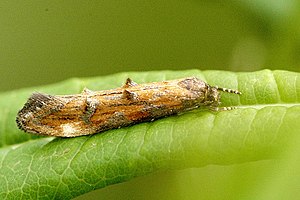Mompha
| Mompha | ||||||||||
|---|---|---|---|---|---|---|---|---|---|---|

|
||||||||||
| Systematics | ||||||||||
|
||||||||||
| Scientific name | ||||||||||
| Mompha | ||||||||||
| Huebner , 1825 |
Mompha is a genus of butterflies fromthe fringed moth family (Momphidae).
features
The representatives of the genus are small to medium-sized butterflies that have the characteristics of the Momphidae family (see description there). The following genera were established in Europe, but most of the authors subsequently downgraded them to subgenus or deleted them: Mompha Hübner , [1825], Anybia Stainton , 1854, Psacaphora Herrich-Schäffer , 1853, Lophoptilus Sircom , 1848 and Cyphophora Herrich-Schäffer , 1853. The following classification is of a provisional nature, since a genus revision is to be expected in view of the many still undescribed species and the great diversity of species in the Nearctic and Neotropical .
Subgenus Anybia
There are tufts with protruding scales on the front wings . The wire M1 is fused with the stem of the wires R4 and R5. The wires M1 and M2 are separated on the rear wings. In the male genital armature, the gnathos is only slightly sclerotized and not bristled. The genital armature of the females has a broad sclerotized antrum .
The genus Anybia was introduced by Stainton in 1854 and later downgraded to a subgenus. The type species is Tinea langiella Hübner , 1796 (= Alucita epilobiella Römer , 1794).
Subgenus Cyphophora
The largest moths of the Momphidae family are represented in the subgenus Cyphophora . In the males, the gnathos has strong bristles. The front wings have large clusters of protruding scales. Only veins R4 and R5 are petiolate on the forewings. On the hind wings the vein M1 is stalked with M2. The female genital armature has only a poorly developed antrum. The ductus bursae is long and narrow. Signa are on slightly sclerotized plates. The larvae are rootworms.
The genus Cyphophora was established by Herrich-Schäffer in 1853 and later downgraded to a subgenus. The type species is Elachista idaei Zeller , 1839.
Subgenus Lophoptilus
There are tufts of protruding scales on the forewings, the CuP vein is stalked with anal veins 1A and 2A. The veins M 1 and M 2 are stalked on the hind wings . The genital armature of the males does not show any pronounced gnathos. In females, the ductus bursae is long and narrow and forms a loop in front of the confluence with the corpus bursae. In Europe there is only one species, the caterpillars feed on rockrose plants ( Cistaceae ).
The genus Lophoptilus was 1848 Sircom erected and later downgraded to subgenus. The type species is Lophoptilus staintoni Sircom , 1848 (= Tinea miscella [ Denis & Schiffermüller ], 1775).
Subgenus Mompha
The forewings are lanceolate and have more or less pronounced clusters of protruding scales. Only veins R 4 and R 5 are petiolate on the forewings. The wires M 1 and M 2 are separated on the rear wings . The genital fittings of the males have a pronounced and curled gnathos. The aedeagus is straight and has a few cornuti. In females, the ductus bursae is short and wide. The antrum is dilated and has sclerotized plates, webs or prickly ligaments that can be used to determine the species.
Subgenus Psacaphora
On the forewings there are conspicuous clusters of protruding scales that are more or less shiny. On the forewings, the CuP vein is stalked with the anal veins 1A and 2A. The veins M 1 and M 2 are stalked on the hind wings . In the male genital armature, the gnathos is poorly developed and membranous. The females have a fairly short ovipositor . The rear edge of the seventh sternite is slightly modified.
The genus Psacaphora was established by Herrich-Schäffer in 1853 and later downgraded to a subgenus. The type species is Tinea schrankella Hübner , 1805 (= Tinea locupletella Denis & Schiffermüller , 1775).
biology
The caterpillars of the species represented in Europe live on the evening primrose family (Onagraceae) of the genera fireweed ( Epilobium ) and witch herbs ( Circaea ), occasionally also on evening primrose ( Oenothera ). The only exception is Mompha miscella , whose caterpillars develop on sun rose species ( Helianthemum ).
Systematics
The type species is Tinea conturbatella Hübner , 1819. The genus Mompha is represented in Europe with 19 species.
- Mompha bradleyi Riedl , 1965
- Mompha confusella Koster & Sinev , 1996
- Mompha conturbatella ( Huebner , 1819)
- Mompha divisella Herrich-Schäffer , 1854
- Mompha epilobiella ( Denis & Schiffermüller , 1775)
- Mompha idaei ( Zeller , 1839)
- Mompha jurassicella ( Frey , 1881)
- Mompha lacteella ( Stephens , 1834)
- Mompha langiella ( Huebner , 1796)
- Mompha locupletella ( Denis & Schiffermüller , 1775)
- Mompha maculata ( Sinev , 1986)
- Mompha meridionella Koster & Sinev , 2003
- Mompha miscella ( Denis & Schiffermüller , 1775)
- Mompha ochraceella ( Curtis , 1839)
- Mompha propinquella ( Stainton , 1851)
- Mompha raschkiella ( Zeller , 1839)
- Mompha sexstrigella ( Braun , 1921)
- Mompha sturnipennella ( Treitschke , 1833)
- Mompha subbistrigella ( Haworth , 1828)
- Mompha terminella ( Humphreys & Westwood , 1845)
The following synonyms are known from the literature:
- Laverna Curtis , 1839
- Lophoptilus Sircom , 1848
- Wilsonia Clemens , 1864
- Leucophryne Chambers , 1875
- Cyphophora Herrich-Schäffer , 1853
- Psacaphora Herrich-Schäffer , 1853
- Anybia Stainton , 1854
swell
Individual evidence
- ↑ a b c d e f g h i J. C. Koster, S. Yu. Sinev: Momphidae, Batrachedridae, Stathmopodidae, Agonoxenidae, Cosmopterigidae, Chrysopeleiidae . In: P. Huemer, O. Karsholt, L. Lyneborg (eds.): Microlepidoptera of Europe . 1st edition. tape 5 . Apollo Books, Stenstrup 2003, ISBN 87-88757-66-8 , pp. 27 (English).
- ↑ a b Mompha at Fauna Europaea. Retrieved September 29, 2011
Web links
- Lepiforum e. V. - Taxonomy and photos